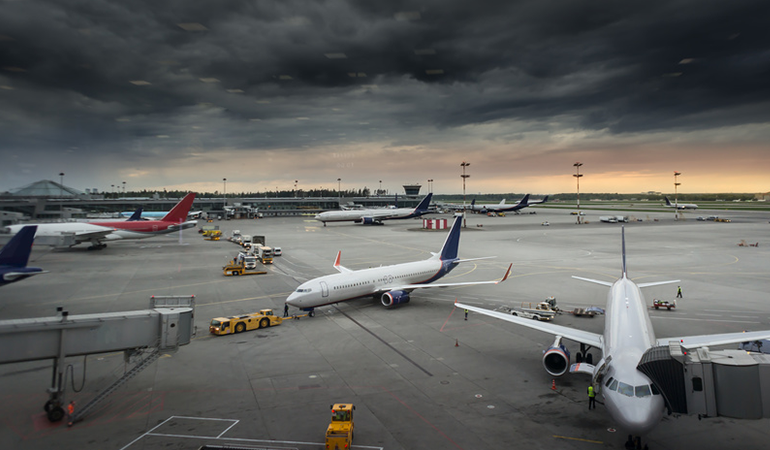What are the consequences of ramp accidents?
Perhaps the most striking component of the ramp accident and safety matrix is just how little was known empirically about the actual cost of ramp-related incidents. According to the Flight Safety Foundation, an estimated 27,000 accidents and incidents worldwide occur per annum which translates to approximately one per every 1,000 departures. Nearly 250,000 people are injured in airport ground operations every year. The annual cost of ramp safety incursions is approximately $5 billion. According to the Flight Safety Foundation, the bulk of these incidents never reach the deductible threshold for insurance, so they end up being direct costs to the responsible organization.
What are the biggest risks on airport ramps?
Airport ramps are inherently hazardous, and certainly not due to any one single risk. Unlike highway workers, where the risk is generally isolated to traffic moving in only two directions. Airports ramps are multidimensional workspaces which have literally dozens of moving components, and those components move nonstop. Take the Hartsfield-Jackson Atlanta International Airport, the world’s busiest airport since 1998, for instance. With nearly 80,000 aircraft operations per month, or roughly 2,600 daily, that makes for an arrival or departure every 33 seconds. Understanding that every aircraft movement requires a certain level of ground support such as fuel, baggage unloading and loading, cargo movements, maintenance checks, and push backs and you can now see how ramp accidents happen. Timetables for aircraft turnaround are very brief by necessity, and there are tasks which must be performed for every single flight. Couple that with the concrete reality that airport ramp space is finite with so many competing interests and it is very clear how ramp safety is threatened.
The main threats to ramp safety
The above factors are assuming a static environment, but airports are anything but static. Operating in concert with the litany of ground service and operations vehicles is the ballet of aircraft moving into, out of and through the ramps. Aircraft run the risk of striking ground support vehicles, other aircraft, and even ground workers.
Jet blast is another significant threat to ground operations while jets are in phases of movement under their own power. Typically, the danger area behind an idling jet is around 200’ (or 60m) but that number increases rapidly as the engines are pushed up through the power setting. The danger area behind a CFM-56 engine, commonly found on the Boeing 737-series of airliners, is 1,200’ (365m) aft at takeoff power setting. Just bumping the throttle up from idle to get the jet rolling for taxi can easily create a dangerous situation for any ground service ramp personnel anywhere near the aircraft. Common ramp accidents stemming from jet blast are overturned wheeled vehicles, injury to personnel, and damage from maintenance stands and tools being blown into parked aircraft.
An equally dangerous though oft overlooked threat to ground operations and ramp safety is inclement weather. Airlines operate in practically all weather conditions, from blowing snow and ice, to thunderstorms and anything in between. Winter weather leads to many injuries in the form of slips, trips, and falls, but it also creates a hazard for support vehicles. With severely reduced braking action, vehicles are prone to sliding into parked aircraft or even encroaching onto active runways and taxiways due to the inability to brake. Traditional aircraft tugs using tow bars pose a particular risk because they count on their own weight and traction to direct the aircraft, as well as stop the aircraft. During slick conditions, whether it be snow and ice, or heavy rain, tugs often lose necessary braking action and the attached aircraft can begin to drag the tug. One effective way to mitigate this adverse action is to consider a tug where the aircraft nose landing gear is cradle onto the tug, therefore adding tremendously to the traction and braking.
How can ramp safety be increased?
Ramp safety can never be considered a static metric. Ramp safety is always dynamic, always moving. However, if there were one component which is a weak link in nearly all incidents, it is inadequate communication. Whether a complete lack of communication between personnel, or a breakdown in existing communications, this generally lies near the root cause, or it compounds the issue in some way or another.
Another means of improving ramp safety is removing extraneous moving parts of the process. Airlines which have migrated towards the use of remote operated tugs now see that the team can safely be reduced with no adverse effect on safety. No longer does the supervisor of the tug have to communicate with the pilot, the tug operator, and wing tip walkers; they now can maintain direct communication with the pilot while performing all other functions of the aircraft movement theirselves.
The phrase “inadequate training” has been burned temporally into most airport operators minds, yet it is absolutely worth its’ weight in gold. It is pushed onto airport ramp teams and personnel because proper training saves assets and ultimately lives. The airport ramp is a highly complex area, and also saturated with traffic and noise. Ramp workers must be kept at the forefront of safety training to remain adept and deft in their work.
What can towbarless and electric tugs do to improve ramp safety?
Electric and towbarless aircraft tugs represent a shift in airport ramp operations. Traditional diesel-powered tugs may have their place in the industry well into this century, but they are becoming defunct for several reasons:
- Diesel tugs with tow bars are difficult to learn to use. Novice tug operators must learn a completely new skillset which is not transferable from anything else or to anything else. When learning to perform pushbacks, the operator must adjust to maneuvering a tricycle-configured vehicle which has two pivot points thanks to the nose landing gear and the pintle hitch. They must also learn to watch wingspans often well in excess of 100’ (30m) for obstruction avoidance, all while monitoring the instructions of the supervisor.
- Diesel tugs do not maneuver like farm tractors or industrial trucks. Aircraft tugs often have three different steering modes, place the driver station in very unusual positions, and have restricted angles of vision. Agriculture tractors and industrial trucks only have one pivot point when towing, and their load is seldom wider than the vehicle itself.
- Diesel tugs do not stop immediately. In fact, they generally take a considerable distance to come to a halt and they are extremely rough during braking.
- Diesel tugs are extremely loud.
Conversely, electric tugs which cradle the aircraft nose landing gear are virtually silent, are naturally intuitive to operate, and brake instantly.
- Electric tugs use a remote control, very similar to a drone or remote control hobby car. The training period of these machines is practically non-existent, and pre-programmed automatic process virtually eliminates the human component of the error chain. The unit lifts the aircraft directly under the nose landing gear which allows unparalleled maneuverability, and 100% visibility for the tug operator, which is absolutely wonderful.
- Towbarless tugs stop instantly, including on predesignated positions if required. Since the full weight of the forward portion of the aircraft rests directly on the drive wheels of the tug, traction is essentially untouched in poor meteorological conditions, nor is braking action.
- Electric tugs make no noise, so there is no distraction from the tug to the operator. Also, the operator is able to act as supervisor and wing/tail monitor because he is no longer tethered to his position aside the tug. He may move into any position he desires to gain the vantage necessary to assure safe aircraft movement.
Speaking from experience, aircraft towing represents critical movements yet becomes so commonplace that it loses much of the element of risk which exists every single time an aircraft is moved. Workers become accustomed to the noise and distraction, along with the very fast tempo of the work and it is easy to lose focus for even just a moment.
Unfortunately, ramp accidents have a way of occurring in just a moment or less. However, the chain of events leading up to the accident is never momentary; it is built off of sometimes years of cutting the same corner. Of course, sometimes it is not cutting of corners, but a momentary lapse in judgement or concentration. Using the best equipment possible is an excellent step in operational risk management, particularly when the equipment is built with redundancies for the expressed purpose of reducing workload on operators and human error. The tug itself is a large piece of this strategic puzzle. Using a tug which makes no noise, stops instantly on command, maneuvers with the precision of a surgeon, and reduces the manpower necessary will absolutely cut into the error chain. When the tow supervisor only has the pilot to communicate with, he now can focus the rest of his attention on guiding the aircraft into position rather than keeping his head swiveling just to keep tabs on the other team members.
Conclusion to ramp safety and the prevention of ramp accidents
Much of the ramp safety paradigm rests on supervision to clearly state and express their vision and expectations. After the words have been spoken, though, it is up to the ramp personnel themselves to execute safe operations. One of the best ways that your company can propagate a safe culture is equipping your ramp teams with the best equipment possible. Replacing your loud, unwieldy diesel tugs with quiet, simple, safe, and efficient electric tugs is a surefire way to not only have a more efficient ramp operation, but a much safer, less cluttered ramp operation.
Reach out to our staff to find out which electric tug is the perfect fit for your particular operation.



Comments